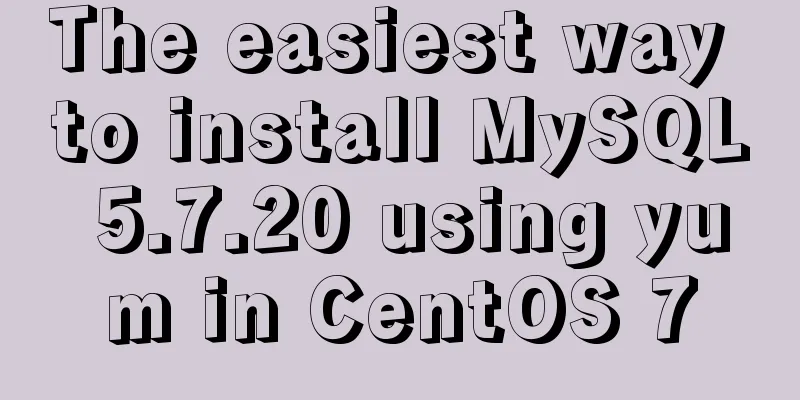The easiest way to install MySQL 5.7.20 using yum in CentOS 7

|
The default database of CentOS7 is mariadb, but many people use mysql. However, there seems to be no mysql by default in the yum source of CentOS7. The previous article installed 5.6, but I want to install 5.7. Yum installation is the easiest. I have tried various compilation and installation problems, and finally decided to use yum. (After a period of study, I wrote another article about installing mysql5.7.22 with source code. Click to open the link) 1. Uninstall. Stop the MySQL process first. If you haven't installed it before, you can skip it. pkill -9 mysqld rpm -qa|grep -i mysql Use the command yum -y remove mysql-community-client-5.6.38-2.el7.x86_64 If you cannot uninstall it, use Uninstall them one by one until there is no 2. Download the mysql repo source. This installs mysql5.7.20 /**Correction, this source downloads the latest version ****/ [root@localhost ~]# cd /usr/local/src/ [root@localhost src]# wget http://repo.mysql.com/mysql57-community-release-el7-8.noarch.rpm [root@localhost src]# rpm -ivh mysql57-community-release-el7-8.noarch.rpm [root@localhost src]# yum -y install mysql-server (You can also specify the installation directory All the way Just follow the steps to install it. Default configuration file path: Configure [mysqld] # # Remove leading # and set to the amount of RAM for the most important data # cache in MySQL. Start at 70% of total RAM for dedicated server, else 10%. # innodb_buffer_pool_size = 128M # # Remove leading # to turn on a very important data integrity option: logging # changes to the binary log between backups. # log_bin # # Remove leading # to set options mainly useful for reporting servers. # The server defaults are faster for transactions and fast SELECTs. # Adjust sizes as needed, experiment to find the optimal values. # join_buffer_size = 128M # sort_buffer_size = 2M # read_rnd_buffer_size = 2M datadir=/var/lib/mysql socket=/var/lib/mysql/mysql.sock server_id = 1 expire_logs_days = 3 # Disabling symbolic-links is recommended to prevent assorted security risks symbolic-links=0 log-error=/var/log/mysqld.log pid-file=/var/run/mysqld/mysqld.pid However, after the installation is complete, the password will be a random password and you will need to reset it. 4. Start the mysql service Reset Password [root@localhost ~]# grep "password" /var/log/mysqld.log You can see that you can enter Next, reset your password: 5.7.20 For security reasons, your password must contain letters, numbers, and symbols. I have fallen into these traps several times. Also, this IP cannot be % I don’t know why. Anyway, the first time I set it to % it didn’t work. I can change it after logging in. How to change your password easily https://www.jb51.net/article/150472.htm alter user 'root'@'localhost' identified by 'Root!!2018'; Finally, remember to refresh the permissions; You can also add new users directly CREATE USER 'root'@'%' IDENTIFIED BY 'your password'; grant all on *.* to 'root001'@'%' identified by 'Root@@' with grant option; Added the root user to be able to log in from any IP address. If you want to restrict login to only specified IP addresses, please replace % with the IP address. Question: If you find that you can’t find the password! ! ! ! ! Solution: You can only change the password by forgetting it!!! Can’t find the password during the installation process? ? ? After struggling for a long time to get it back by changing the password, I found that the database I had installed before was still there, but no new database was generated! ! The previous configuration is still used. 2. Check if mysql is started? Have you initialized the database? Generally, you can directly start the database and use grep "password" /var/log/mysqld.log to see the random password. Modify MySQL login settings: Add the following line to the [mysqld] section: Restart mysqld
Restart mysqld
#/etc/init.d/mysqld restart ( service mysqld restart )
use mysql
update user set password=password("12345") where user="root";
The MySQL 5.7 database does not have a password field, but uses the authentication_string field. mysql> update mysql.user set authentication_string=password('root') where user='root';
flush privileges; Change the password and then change it back. Summarize The above is the easiest way to install MySQL5.7.20 using yum under CentOS 7 introduced by the editor. I hope it will be helpful to everyone. If you have any questions, please leave me a message and the editor will reply to you in time. I would also like to thank everyone for their support of the 123WORDPRESS.COM website! You may also be interested in:
|
>>: Sample code for deploying ELK using Docker-compose
Recommend
The difference between Div and table in HTML (discussed in detail in all aspects)
1: Differences in speed and loading methods The di...
Docker solution for logging in without root privileges
When you use the docker command for the first tim...
Example code for building an admin dashboard layout using CSS and JavaScript
What you will create In this new tutorial, we'...
Summary of important components of MySQL InnoDB
Innodb includes the following components 1. innod...
Example of how to configure multiple virtual hosts in nginx
It is very convenient to configure virtual host v...
How to purchase and initially build a server
I haven't worked with servers for a while. No...
Detailed explanation of Vue development Sort component code
Table of contents <template> <ul class=&...
How to make vue long list load quickly
Table of contents background Main content 1. Comp...
Introduction to JavaScript array deduplication and flattening functions
Table of contents 1. Array flattening (also known...
CSS3 implements missing corner rectangle, folded corner rectangle and missing corner border
Preface A few days ago, I came across the feature...
How to change the CentOS server time to Beijing time
1. I purchased a VPS and CentOS system, and found...
Vue two fields joint verification to achieve the password modification function
Table of contents 1. Introduction 2. Solution Imp...
Detailed explanation of rpm installation in mysql
View installation and uninstallation # View rpm -...
A bug fix for Tomcat's automatic shutdown
Preface Recently, a Java EE web project that has ...
Example of implementing the Graphql interface in Vue
Note: This article is about the basic knowledge p...









